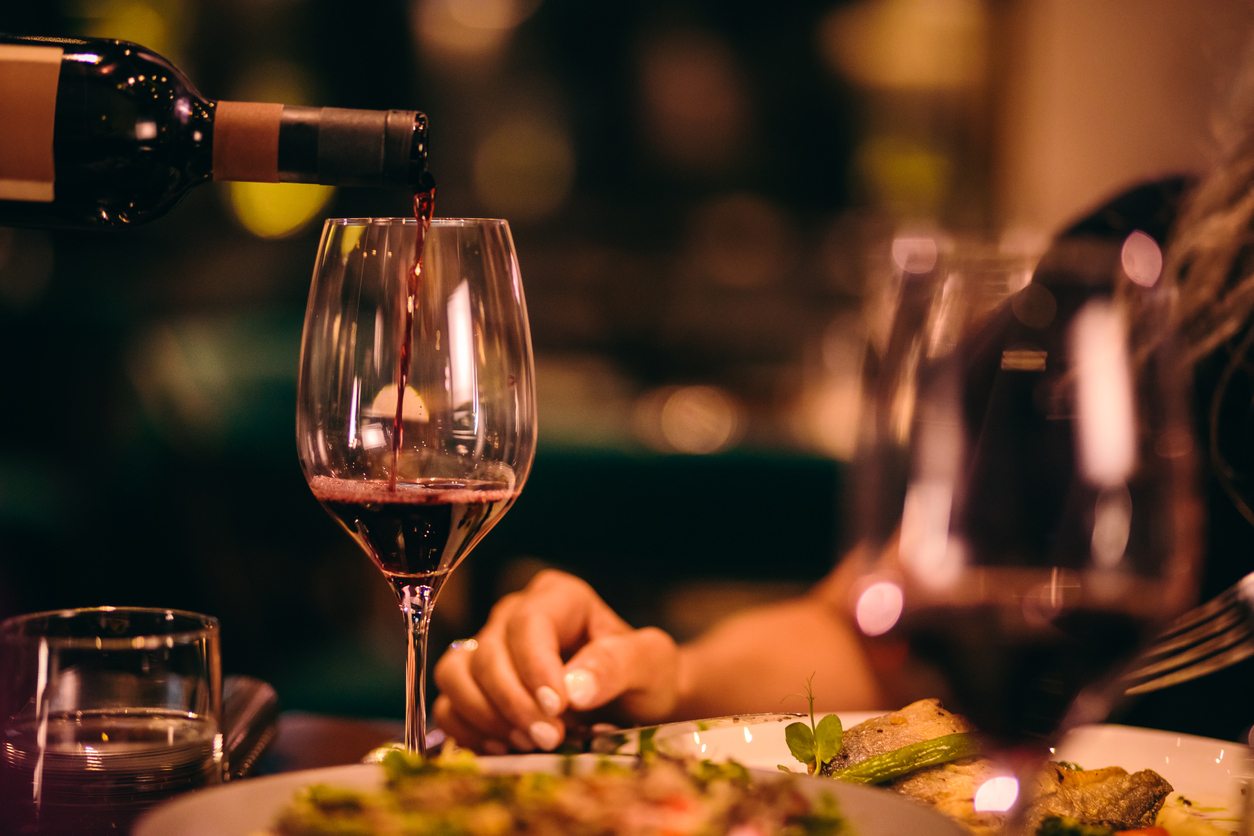Like the final touches on a masterpiece, a good wine pairing can take an otherwise humble meal and transform it into something truly magnificent. There is something almost spiritual to the enjoyment of a good glass of wine, especially if served alongside a delicious meal, but figuring out what wine will bring out the best in a dish can feel as challenging as dating. With all the options available today, pairing wines and food can seem like a terrifically challenging task, especially if you’re new to wine appreciation. Sommeliers, a.k.a. professional wine pair-ers, can take years learning how to professionally pair wines, and they still have to pass rigorous exams to be recognized in their field. It’s no wonder most people never dive into the wine pairing pool – it’s just so vast!
This may all sound pretty intimidating, but unless you’re planning on working in a world-class restaurant, wine and food pairing is actually surprisingly straightforward. With a few basic principles and a little wine know-how, anyone can start elevating their meals with the right wines! We’ll break down the basic principles of wine and food pairing, as well as walk you through basic pairing strategies for each style of wine. Whether you’ve only recently begun to enjoy wines or you’ve been appreciating wines for years, we’ll give you the tips you need to start pairing wines like a pro.
Bringing Balance
When trying to understand the flavors in wine, it’s best start at the beginning: it all comes back to the grapes. Where wine grapes are grown (known as the appelachian) and how they’re processed certainly affects the flavor of the final wine, a factor which is most obvious when comparing whites and reds. Red wines are fermented with the grape skins left in the mix, lending these wines their signature color and strong tannic or bitter elements in the flavor. Contrastingly, white wines are fermented without their skins, giving them a light color as well a far lighter and brighter flavor. In that same vein, the character of a rosé can be drastically altered based on whether the wine is blended with other wines or if the skins are allowed to soak briefly in the juice before fermenting. These slight differences in process create drastically different wines, and it is these kinds differences at every step of production that help to give wines their character.
There are also certain flavor characteristics that are inherent to each varietal. You may have heard that certain wines are “jammy” or “peppery”; while these flavors are affected by the processes listed above, many of the characteristics we most associate with specific wines are simply part-and-parcel with that varietal. For instance, chardonnay grapes will always have some degree of intense, bold flavors reminiscent of various fruits, honey, hazelnut, and even butter. These bright flavors pair beautifully with the delicate but intense earthiness of simply prepared mushrooms and fungi, cutting through the richness without over-powering the dish’s flavor. Remember, you’re looking to create a balance between the flavor of the food and the flavor of the wine; a good pairing will enhance the flavor of a dish, not overpower it. An easy rule of thumb is to choose a wine that’s the same intensity as a dish – bold, bitter reds will pair best with fatty meats and rich braises, while whites will pair better with lean poultry and seafood. You can also look for wines that are both sweeter and more acidic than the dish itself, but be warned against trying to pair wines with foods that are themselves both sweet and acidic. Fruits like melons and citrus will have an astringent effect on the palate, and this can turn the flavor of even the finest wine sour and gross.
A Pairing For Every Shade
So far, we’ve been talking about wine in terms of red and white wines, but to truly understand the scope of pairing possibilities, we’ll have to break these terms down a bit. Under these broad wine umbrellas, there are a number of sub-categories that can in turn be broken down into individual wines. By using these sub-categories instead of the broader umbrella of “red” or “white”, you’ve already narrowed down your scope of pairing possibilities, making it ultimately a lot easier to find the right wine for a particular meal. Check out our handy breakdown below!
Bold Red
This category includes wines like Cabernet Sauvignon, Petit Verdot, Petite Sirah, Malbec, and Syrah. These wines are full-bodied and quite tannic, a result of their tendency for high alcohol content. This makes them perfect for cutting through equally bold, fatty foods like red meat, cured meats, hard cheeses, and even richly prepared mushrooms. We like a bold red with this Ossobuco, it’s the perfect pairing for a cold fall night.
Medium Red
Typified by wines like Cabernet Franc, Rhone, Sangiovese, Zinfandel, and Merlot, this is a category of very popular reds. The wines tend to have noticeable red and black fruit characteristics and are less tannic than bolder wines, making them more versatile in their pairing options. They go well with red meat and pork, hard cheeses, and can even stand up to spice.
Light Red
Lights reds include Pinot Noir, Grenache, Carmenere, Gamay, and Chianti, among others. These wines are the least tannic of the reds, making them light-bodied and more acidic than their darker cousins. Though the flavor is far less intense, these qualities make them almost perfect table wines. Their mild flavor goes beautifully with foods like pork, various cured meats, poultry, pungent soft cheeses, and mushrooms. Try your favorite with Chicken Cacciatore for a pairing experiment you won’t regret.
Rosés
Ranging from dark to light and dry to sweet, rosés are really a genre unto themselves. This broad category of wines is a mish-mash of varietals treated with various fermentation techniques, including White Zinfandel, Rosé of Pinot Noir, Rosé of Grenache, and a number of regional Rosés from France and around the world (to learn more about what really makes a rosé a rosé, click here). On the whole, rosés tend toward a bright, balanced acidity and noticeable red berry, stone fruit, and even tropical fruit characteristics, all on the spectrum of dry to lightly sweet. Rosés pair especially well with vegetables, particularly squash, but they will also compliment rich shellfish and even poultry. Choose a bold rosé to go with this Creamy Curried Butternut Squash Soup for a healthy meal.
Bold White
Boldly rich and buttery, these are wines like Chardonnay, Viogner, Trebbiano, Semillon, and Roussanne. The whites tend towards bold acidity and pronounced dryness, and many see their flavor benefit greatly from aging in oak barrels. Pair these wines with lean meats like poultry and seafood, or serve them alongside creamy soft cheeses and simply prepared mushrooms. We love a bold white with this Mushroom Quiche for the perfect brunch bite.
Light White
Moving to the lighter and brighter side, this category includes wines such as Sauvignon Blanc, Albarino, Chenin Blanc, Pinot Grigio/Gris, Picpoul de Pinet, and Vermentino. These wines tend towards herbaceous and acidic flavors, with a light body and notes of green peppers and fresh herbs. This category is a classic for pairing with seafood and goes well with mollusks, fish, and shellfish equally. These wines are terrific alongside light preparations of poultry, veggies, and mushrooms, and pair beautifully with a variety of hard and soft cheeses. Enjoy a glass with succulent Butter-Poached Halibut to truly appreciate these refreshing wines.
Sweet White
Ranging from bold to light, sweet wines include those like Gewurztraminer, Moscato, Riesling, Sauternes, and Madeira. These wines blur the line between sweet and savory, and many pair equally well with light savory dishes as they do with certain sweets. For a savory pairing, try them with seafood, veggies, cured meats, and spice, or go for a sweet pairing with buttery pastries or possibly even chocolate.
Dessert
Often fortified with grape or other spirits, dessert wines are a truly sweet category of wines that include Port, Sherry, Norwegian Ice Wine, Vin Santo, and Hungarian Tokay Aszu. The flavor profiles are sweet with a kick of alcohol in the fortified wines, while others can thank a late harvest for their sweetness, allowing the fruit to achieve maximum sugar content on the vine. Pair them with fruit and nuts, baked desserts, cured meats, and pungent cheeses.
Sparkling
Sparkling wine isn’t just a treasure for its bubbles – this style of wines is also a true pairing powerhouse. Including sparklers like Brut Champagne, Prosecco, Cava, Riesling Sekt, and Sparkling Rosé, sparkling wines can range from dry to sweet depending on their grapes and fermentation (to learn more about sparkling wines, click here). Pair them with all manner of meats, cheese, seafood, veggies, and more – even dessert goes with a glass of sparkling wine! Raise a glass over a bowl of homemade Bouillabaisse for a traditional and luxurious pairing.
All of these wines will also pair with bread, so make sure you’ve got a good loaf hanging out any time you crack open a bottle. Stop by Oliver’s this week and take your pick of the 2021 Harvest Fair’s award winning wines! With great Sonoma County wine selections and the Oliver’s expertise you’ve come to know and love, it’s the perfect way to bring home your new favorite bottle and start making wine and food magic tonight!


Comments
Add a commentYou’re not alone, but luckily Montalto has some food and wine pairing guidelines that will have you wine matching like a sommelier before you know it. The web’s most comprehensive food and wine pairing resource with thousands of expert ideas and tips on food and wine pairing.
Comment by Robert Charles on October 4, 2021 at 11:12 pm
Wine and food pairings can be a little tricky. But this comprehensive guide help me with that. Thanks!
Comment by Sula Vinyards on July 19, 2022 at 12:55 am